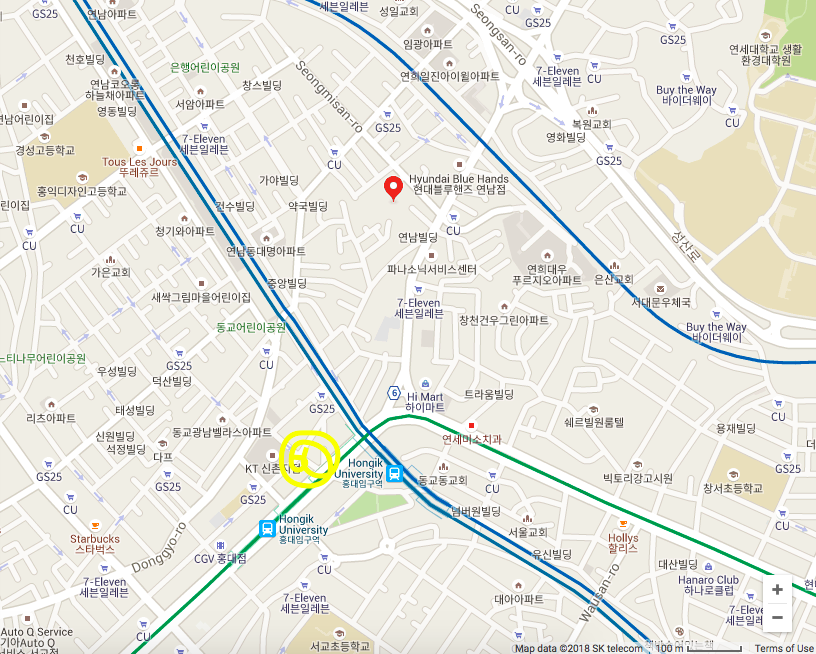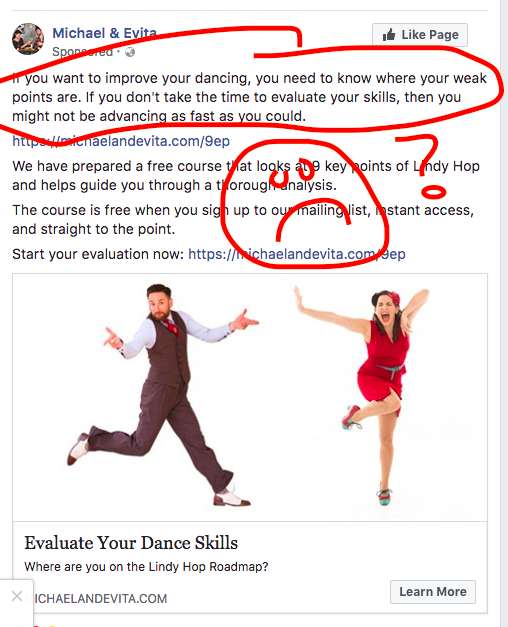I’ve recently been pushing to teach lindy hop using only positive reinforcement.
When the students are doing an ‘experiment with these things please’ session in class (and they do a lot of this independent, self-guided learning in class), we used to watch until we saw common errors or patterns of messed up movement. Then we’d stop and correct the students, saying things like “Instead of doing this, do that.” I had been advised by a teacher friend (Shane McCarthy in Perth) never to ‘correct’ a student in class in front of the group because it’s embarrassing and trashes their morale. But it’s taken me until just this year to realise that I never need to correct a student again.
‘Correction’ is another word for ‘telling students they’re doing things wrong, that they’re wrong.’ And this is shit for morale. Both students’ and ours. Because if you’re going to tell someone they suck, you feel terrible. Unless you are a somewhat shit person. I used to go home from class worried that I’d said the wrong thing, or taught them something bullshit.
Until I noticed that when I said, “Oh, you know what I saw that I really liked? ….” and then pointed out where someone specific had done something really nice, or in general when I saw something I liked, the students felt great, and I felt wonderful.
In our teaching pairs, we used to have a rule for reducing the amount of time we spent teaching: say one thing for follows, and one thing for leads. Thing is, these things were almost always ‘tips’ or corrections. So we were effectively making a rule: ‘say one thing to trash the follows, then one thing to trash the leads.’ Boo!
But then we started encouraging each other to say “Something that I saw that I liked…” And YES. The world got really really good. Yay!
So this year I made a rule for myself, which I’ve then asked all my teaching partners to do when the teach with me: if you want to guide students towards a particular behaviour, wait until you see a student or students doing that behaviour (or on the road to that behaviour), and then say, “I saw some people doing X. It was really nice.” You be very specific about what you saw, and if you think that student can handle the attention, name them: “I saw X and Y dancing away, then get into a tangle, and you know what they did? X said, “Can we stop for a tick so I can try again?’ And they stopped and chilled for a second, grooved til they found their timing, then they started it again. That was a really cool way of dealing with a mess.” If you see a bunch of people doing a thing, say that: “I saw a bunch of people doing X and I loved it.”
Or if you see ALL of them doing something – tell them! I tend to gush on this one: “Oh! That looked so nice and _grooving_ because you all took a bit of time to make friends with the music before you got going, and then you kept that groove!” I also like to point out how people have managed their own mistakes: “I really liked the way you guys started dancing, and it was nice, but a bit square” [demonstrate timing], “And then the music started, you all heard the musicians, and you all changed your dancing so it swung” [demonstrate swinging timing].
So now my rule is: no ‘corrections’, no ‘tips’. Just positive affirmations. If you don’t see the behaviour you need or want to see, wait. Because they’ll get there. If they don’t, then you need to show them again. And that’s ok.
Key to this is that you are looking at students looking for ways in which they are wonderful, rather than ways in which they are rubbish. It just made teaching so wonderful.
But let’s look more at this idea of positive reinforcement replacing correction in teaching.
Today, I read a book called ‘Getting Started: Clicker Training for Dogs’ by Karen Pryor, because we’re trying to teach our nutty, somewhat panicky rescue dog a few tricks, but also so she feels more confident and happy when we’re out, and when we’re around the house. This book is just lovely. Mostly because clicker training rewards good behaviour rather than punishing or correcting ‘bad’ behaviour. It also encourages you – the trainer – to look for goodness in your subject, not badness or errors. And hence, brings good vibes. As the book says
Once you get used to thinking the clicker way, you are much more likely to notice good behavior and reward it, instead of giving your attention to a child only when it’s doing something wrong.
More importantly for trainers, it’s much easier to maintain preferred behaviour with this method than with “physically correcting erroneous behaviour”.
Let me just note that point: it encourages teachers to actively look for good behaviour. It changes the teacher.
How does it work?
First, you encourage learning-by-exploring.
When your doggo does a behaviour close to what you want, you click your clicker and give it a treat. So if I want Frank to sit, if she stops, she gets a click and a treat. If she starts to lower her rear haunches, I click and she gets a treat. If she actually sits – click! And treat bonanza (lots of treats)! Important: you only click once, exactly as you see the desired behaviour. They then associate the click with approval for what they are doing _at that time_. You never punish or correct or tell them off. If they deviate substantially from what you want, you put the clicker and treats away. No more treats.
So we have the second point: you encourage learning by approval and positive reinforcement, not correction and punishment/disapproval.
I’ve heard of positive reinforcement, of course, but I’d never really thought about what I was doing as a teacher as positive reinforcement.
The goal: the doggo learns that their behaviour gets you to click and give you treats. So they start thinking: what can I do that will make the human click? And they start experimenting.
You can immediately see how this works for lindy hop: what can I do that will make my partner smile, and dance really well making for a good dance and fun time for both of us? You can also see that this approach forces you to shift the learners’ focus from you, the teacher, to each partners. Ha. Yes. Your ego will need to be set aside for minute!
But this approach also works for teaching: what sort of things can I try to that will get me a good result? What interesting things can we do to make the students and us happy? How much fun can we actually have in class? And I tell you, friends: it’s addictive. If you can have a little bit of fun once, you suddenly think LET’S HAVE A LOT OF FUN ALL THE TIME.
This encourages a happy, creative pupper, but also happy, creative dancer. Ta da! Lindy hop!
This book extends this approach to teaching other animals besides dogs (it was actually developed with dolphins), and then to teaching children. Apparently this method works particularly well with humans learning physical skills, because it’s so quick. Not only are you giving positive reinforcement, but you’re also physically making a nonverbal sound (clicking the clicker) when you see the behaviour you want. And retention of these skills is permanent, with learning happening twice as fast as with verbal instructions.
The question then becomes: can we use a clicker in a lindy hop class? If not, what non-vocal substitution would work?
As a clear example, when you learn African dance with drummers in class, the drummers signal a change in the exercise or step or rhythm with a very clear rhythmic sound. And if you’re doing a nonverbal warm up like i-go, you-go, the teacher moves on from one rhythm or one shape to another when you get it right. Hmmm. Close, but not quite right.
I have noticed myself that if I use words to signal my approval or to signal ‘Yes! you are on track!’ to students, the language itself interrupts their processing of information. This is no doubt because, as we know, humans can’t/aren’t much good at processing words and physical lead/follow information at the same time.
So let’s look at another example from black culture (which is where of course lindy hop began): the call-and-response “Amen!” of a congregation responding to a preacher. It is a word, but it’s used so often that it has become more of a ‘sound’ than an actual Word. It means ‘yes!’ and ‘I hear you!’ and ‘praise that/you!’
Even within a mainstream white culture, women talking in groups use non-verbal signals of approval to encourage speakers in conversation: the raised eyebrow, the exclamation of breath, a laugh-sound.
What sort of nonlingual verbal cues can we use?
The other key element in clicker training is to do with the trainers: you learn to
respond in new ways. You become used to the idea that behavior needs to be built in small pieces, not in big chunks. You stop expecting too much, too soon, and just look for what you can reinforce – and so in fact you get more results, and better.
If you see a behavior you don’t like, …instead of rushing in to prevent it or stop it, you take it as a training opportunity: what is it this learner needs to know? What’s missing? What can I add that would replace this bad behavior?… you have a better way – reinforcing what you like, instead of attacking what you don’t.
…The experience can lead to less stress and more fun in life in general.
Ah!
This is another approach that we’ve really jumped onto in our teaching. The idea of slowly building up skills in pieces. So instead of starting a class by saying, “Today we will learn the swing out!” and then proceeding to show a move, then break it into pieces, then map it out, then have them do each bit, we start with a related foundational skill. We need a few things for swing outs: a sense of timing (ie the beat), a rhythm (ie a way of moving through space predictably), and a partner. To work with a partner, we need to know how to touch them, how to communicate with them (to know what they want/like and to tell them what we want/like), and to know how they feel the music.
So we begin with the first part: how do we move our bodies? Then we move on to the next part: how do we dance with a partner? Then we get them using all these elements (rhythm, shared beat, partnering skills, movement, etc) to do a simple task – move around the room randomly, experimenting. We ask them, “What helps? What makes this easier? What was the funnest part?”
Then we ask them to do a specific task: to dance a circle. But we literally say, “Now look here.” We show them. They watch. Then we say, “Please give your best approximation of this.” They do it. Boom circles. This has taught them not only a specific move, but it’s also taught them to experiment and try. And they get rewarded for that. But the move itself also teaches them to feel and experiment with rotational momentum… or, in human words, to feel that wonderful spinny roundy feeling.
Then we say, “Please let go half way.” And they basically recreate throwing a ball on a string. A swing out. And you give them TREAT BONANZA. Both in terms of praise, but you also point out: now you have a very fun move. And you set them loose to play with it to music.
All this plus a couple of jazz steps and warms ups and things is our first class. They have learnt a swing out. But they have learnt a million other skills as well as this one move. And the skills are more important.
For us, as teachers, we’ve learnt that a swing out isn’t a ‘thing’ that you give a student. It’s a thing that they discover through guided experimentation.
You want to keep doing positive reinforcement because it gives them the confidence to try, and to make mistakes, and then to see what happens when they do it in this way or that way. Which is, of course, how the swing out was born historically.
Clicker training in brief
– click the behaviour you want, exactly when it happens
– reward/treat after you click
– only work positively: reward what you want, or actions that get closer to what you want; never punish
– work in incremental steps towards a bigger goal
Key elements of clicker training:
– encourage the learner to experiment with all sorts of things until they figure out what behaviour will get a click (and a treat)
– you, the teacher, have to look actively for things to reward/click. This often means the learner does things you don’t expect, which gets them closer to the goal
– you, the teacher, get more flexible and learn more
– the learner is learning experiment with doing all sorts of things with the goal of changing _your_ (the teacher’s) behaviour (ie to get you to click)
Conclusion
It is epic fun for everyone, because you focus on positive outcomes and reinforcement, rather than correcting and punishing.
Interesting thing:
The clicker is absolutely key because it is an aural, nonverbal cue. It gets twice as fast learning than a verbal cue. Because it side steps the longer word-processing-learning of verbal cues. It’s _faster_ because your brain doesn’t need to untangle the words. Your brain is faster with nonverbal cues.
It also works on doggos.
Challenge: clicking is kind of harsh, socially.
An example of a pretty structured tagteaching (which uses clicker training).






